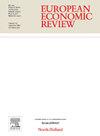供给冲击、就业缺口和货币政策
IF 2.4
2区 经济学
Q1 ECONOMICS
引用次数: 0
摘要
从通胀和稳定就业的角度来看,货币政策应该如何应对供给冲击?我们在一个标准模型中引入劳动力的进入和退出,该模型具有交错的价格和工资设定,以将就业纳入模型。福利最大化政策的特点是工资增长稳定伴随着就业差距和通货膨胀的变化。在价格和工资交错设定下,对冲击的实际工资调整会产生福利成本,而就业差距的变化有助于降低福利成本。因此,与福利最大化政策相比,倾向于就业差距会导致供给冲击带来实质性的福利损失。本文章由计算机程序翻译,如有差异,请以英文原文为准。
Supply shocks, employment gap, and monetary policy
How should monetary policy respond to supply shocks in terms of inflation and employment stabilization? We introduce labor force entry and exit in an otherwise standard model with staggered price- and wage-setting to include employment in the model. A welfare-maximizing policy features wage growth stabilization with variation in the employment gap and inflation. Under staggered price- and wage-setting, the real wage adjustments to shocks entail a welfare cost, and variation in the employment gap contributes to reducing the welfare cost. Therefore, leaning against the employment gap induces substantial welfare losses for supply shocks compared to the welfare-maximizing policy.
求助全文
通过发布文献求助,成功后即可免费获取论文全文。
去求助
来源期刊

European Economic Review
ECONOMICS-
CiteScore
4.70
自引率
3.60%
发文量
170
期刊介绍:
The European Economic Review (EER) started publishing in 1969 as the first research journal specifically aiming to contribute to the development and application of economics as a science in Europe. As a broad-based professional and international journal, the EER welcomes submissions of applied and theoretical research papers in all fields of economics. The aim of the EER is to contribute to the development of the science of economics and its applications, as well as to improve communication between academic researchers, teachers and policy makers across the European continent and beyond.
 求助内容:
求助内容: 应助结果提醒方式:
应助结果提醒方式:


